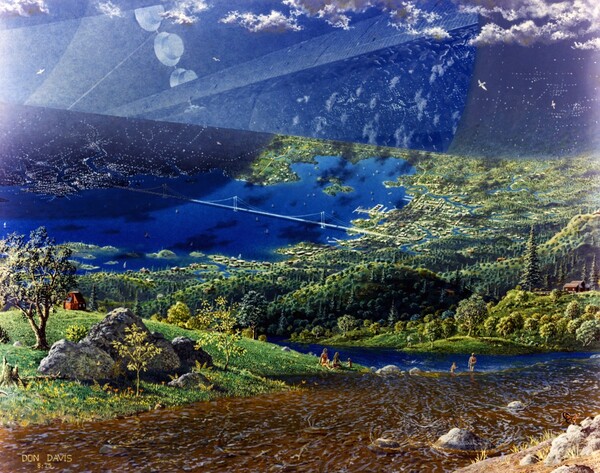This article explores: The engineering behind O’Neill Cylinders: Challenges and solutions for sustainable space habitats. Find out more about O’Neill cylinders engineering challenges and solutions.

The concept of O’Neill Cylinders offers a promising solution for long-term human habitation in space, but its engineering is a challenging endeavor.
Building an enormous, rotating cylinder that can sustain human life requires innovative design, advanced materials, and sophisticated systems engineering. In this article, we will explore the key engineering challenges that must be overcome to create sustainable space habitats using O’Neill Cylinders, as well as the potential solutions for each challenge.
From the construction of the cylinder to the design of life support systems, maintaining stability and rotation, and ensuring long-term sustainability, we will delve into the complex engineering behind these futuristic space habitats.
Is Building O’Neill Cylinders A Better Idea Than Colonizing Planets And Terraforming Them?
The answer to this question depends on several factors, including the specific goals of space colonization and the technological capabilities available to achieve them.
On the one hand, building O’Neill cylinders offers several advantages over colonizing planets and terraforming them.
O’Neill cylinders
O’Neill cylinders can be constructed using existing technologies and materials, whereas terraforming a planet would require a much more extensive and complex process, and it may not be feasible for many planets.
O’Neill cylinders could be designed to provide a self-sustaining environment with controlled living conditions, while colonizing a planet would require adapting to a new and potentially harsh environment with many unknowns.
Colonizing planets and terraforming them
Colonizing planets and terraforming them could offer the potential for creating new Earth-like environments, which could support a wider range of life forms and ecosystems. Terraforming could also provide new opportunities for resource extraction and scientific exploration.
Ultimately, both O’Neill cylinders and planet colonization have their advantages and limitations, and the best approach may depend on the specific goals and resources available for space exploration and colonization. It is possible that a combination of these approaches may ultimately be used to achieve humanity’s long-term goals in space.
What Is The O’Neill Cylinder Model?
The O’Neill Cylinder is a conceptual design for a large, rotating artificial habitat that could support human habitation in space. It was first proposed by physicist Gerard O’Neill in the 1970s as a possible solution to the challenges of long-term space colonization.
The O’Neill Cylinder model consists of a cylindrical shell that rotates around its longitudinal axis to create artificial gravity. The cylinder would be several miles long and several hundred feet wide, providing ample living space for a self-sustaining human colony.
The interior of the cylinder would be divided into multiple levels, with living areas, agriculture, manufacturing, and other infrastructure distributed throughout. The outer surface of the cylinder could be used for solar power generation and agriculture, providing fresh produce and supporting the colony’s energy needs.
The cylinder would be located in space, potentially in a Lagrange point, which is a point in space where the gravitational pull of two celestial bodies is balanced. This would provide a stable environment for the colony and allow it to be positioned for optimal resource utilization and scientific research.
The O’Neill Cylinder model has been explored in numerous studies and has inspired many other concepts for large-scale space habitats. While the concept remains theoretical, it offers a potential path forward for long-term human habitation in space and could play a key role in humanity’s future exploration and colonization of the solar system.
Can O’Neill Cylinders Perfectly Control The Environment Inside?
While O’Neill Cylinders are designed to provide a self-sustaining environment for human habitation in space, it may not be possible to perfectly control the environment inside. Some factors, such as radiation exposure and micrometeorite impacts, may be difficult to completely mitigate.
However, the O’Neill Cylinder design offers several advantages for controlling the environment inside. The rotation of the cylinder creates an artificial gravity that would allow humans to live and work in a more natural and comfortable environment, with less of the negative effects associated with microgravity.
The cylinder could also be designed with advanced life support systems, which could recycle and reuse resources as much as possible, minimizing waste and ensuring sustainability. These systems could also help control factors such as temperature, humidity, and air quality, creating a more comfortable and healthy living environment for the colony.
Additionally, the closed environment of the O’Neill Cylinder could help control factors such as atmospheric composition and pressure, providing a stable and predictable environment for the colony. The colony could potentially have advanced environmental monitoring systems in place to detect and respond to any changes or anomalies.
Overall, while it may not be possible to perfectly control the environment inside an O’Neill Cylinder, the design offers several advantages for creating a stable and sustainable living environment for a human colony in space.
How Can We Stabilize O’Neill Cylinder Rotation?
Stabilizing the rotation of an O’Neill Cylinder is critical for maintaining a comfortable and stable living environment for the colony.
Without proper stabilization, the rotation could become irregular or even stop altogether, causing a loss of artificial gravity and potentially harmful living conditions for the colony.
One of the primary methods for stabilizing the rotation of an O’Neill Cylinder is to use reaction wheels or gyroscopes. These devices can spin up or slow down the rotation of the cylinder to maintain a stable rotation rate. Additionally, attitude control systems can be used to adjust the orientation of the cylinder to maintain a stable position in space and prevent unwanted oscillations or drift.
Another approach is to use external forces, such as thrusters or electric currents, to apply torque to the cylinder and adjust its rotation rate. This method may be less efficient than using reaction wheels or gyroscopes, but it could be useful in certain situations, such as during a collision with space debris or other objects.
Finally, the design of the cylinder itself can play a role in stabilizing its rotation. By distributing the weight and mass of the colony evenly around the circumference of the cylinder, and by using counter-rotating sections or other features to balance out any asymmetries, the cylinder can maintain a more stable rotation rate.
Overall, stabilizing the rotation of an O’Neill Cylinder is a critical aspect of its design, and there are several methods and techniques available for achieving this goal. A combination of these approaches may be used to ensure a stable and comfortable living environment for the colony.
Challenges of O’Neill Cylinder Engineering
While the O’Neill Cylinder offers a promising solution for long-term human habitation in space, there are several significant engineering challenges that must be overcome in order to realize this vision.
One major challenge is the construction of the cylinder itself. The cylinder would be several miles long and several hundred feet wide, making it one of the largest structures ever built.
The materials needed for construction, such as metals and composites, must be strong enough to withstand the stresses of rotation and radiation exposure, while also being lightweight enough to be launched into space.
Another challenge is the design and construction of the life support systems needed to sustain a human colony in space. These systems must be highly efficient and reliable, recycling and reusing resources as much as possible to minimize waste and ensure sustainability.
The systems must also be able to control factors such as temperature, humidity, and air quality, creating a comfortable and healthy living environment for the colony.
Maintaining the stability and rotation of the cylinder is another critical challenge. The rotation must be precisely controlled and stabilized to provide a consistent and comfortable level of artificial gravity throughout the cylinder.
The use of reaction wheels, gyroscopes, and other systems can help achieve this goal, but they must be designed and implemented with a high degree of accuracy and reliability.
Finally, the O’Neill Cylinder will need to be designed with the long-term survival and sustainability of the colony in mind. This includes providing sufficient food, water, and energy resources, as well as addressing potential issues such as radiation exposure, micrometeorite impacts, and other hazards of living in space.
Overall, while the O’Neill Cylinder offers a promising solution for long-term space colonization, significant engineering challenges must be overcome in order to make this vision a reality. Addressing these challenges will require a combination of innovative design, advanced materials, and sophisticated systems engineering.
References for: “The engineering behind O’Neill Cylinders: Challenges and solutions for sustainable space habitats”
“The High Frontier: Human Colonies in Space” by Gerard K. O’Neill – This classic book provides an overview of the concept of O’Neill cylinders and the engineering challenges associated with building and sustaining them.
“Space Structures: Principles and Practice” by Subramanian Narayanan – This book provides a comprehensive overview of the design and engineering of space structures, including O’Neill cylinders.
“Space Settlements: A Design Study” by NASA – This study, conducted in the 1970s, examines the engineering and design challenges of space colonies, including O’Neill cylinders.
“Colonies in Space” by T.A. Heppenheimer – This book explores the technical challenges of space colonization, including the design and construction of O’Neill cylinders.
“Space Architecture: The New Frontier for Design Research” edited by Neil Leach – This book includes a chapter on O’Neill cylinders and the engineering challenges associated with creating sustainable space habitats.
“Materials and Structures for Space Applications” edited by Peter W. Merlin – This book provides an overview of the materials and structures needed for space habitats, including O’Neill cylinders.
“Living Aloft: Human Requirements for Extended Spaceflight” by NASA – This report examines the engineering challenges associated with long-term spaceflight and discusses the potential solutions for sustainable space habitats, including O’Neill cylinders.
“Space Settlement Basics” by Al Globus – This essay provides an overview of the engineering and design of space colonies, including O’Neill cylinders.
“Mining the Sky: Untold Riches from the Asteroids, Comets, and Planets” by John S. Lewis – This book explores the economic possibilities of space exploration and colonization, including the engineering challenges of creating sustainable space habitats like O’Neill cylinders.
“Space Manufacturing 3: Proceedings of the Fourth Princeton/AIAA Conference” edited by John H. Hoffman and Frederick A. Candelaria – This conference proceedings book includes papers on the engineering challenges of space manufacturing, including the design and construction of O’Neill cylinders.
‘The engineering behind O’Neill Cylinders: Challenges and solutions for sustainable space habitats’ is one important topic in our series exploring the role of O’Neill Cylinders in space colonization.
Read more about these topics by following the links below:
Republished by Blog Post Promoter
